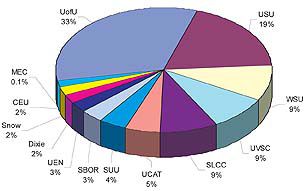| Operational funding for higher education in Utah for fiscal year 2008 will total more than $1.2 million. Utah’s system of higher education includes nine colleges and universities operating at locations across the state. |
The standard issues of transportation, education and human services funding will remain the key points at the Utah legislative session set to begin in Salt Lake City next week. But news regarding the way the public can access information about what lawmakers are doing is noteworthy.
With the development of the Internet as an information source, the state provides links on the legislative Web site so residents in Carbon County and across Utah can view the status of bills and listen to committee sessions and floor debates.
“I think this is one of the things people need to know about,” said Rep. Brad King, who represents district 69, covering two-thirds of Carbon County and much of Emery County. “It will help keep people informed about issues in a very up-to-date manner.”
The legislative site may be viewed at http://www.le.state.ut.us/. Information is updated as quickly as possible and the site is often among the earliest to report the outcome of the meeting.
Along with bill status and reports on social and legal issues, Internet users may view how specific bills will affect the state’s budget.
“Funding is always the bugaboo,” said King. “The legislative analysts are projecting a $1.5 billion surplus this year, with $700 million of that being one time money. That means there will be a lot of debate on where those extra funds should go.”
Transportation is becoming a bigger issue every year, with the state’s growing population – one of the highest growth rates in the country – and industries moving to Utah in a steady stream. Still, much of the state’s budget goes to public education.
King, a Democrat in a largely Republican dominated house, serves on a number of committees including transportation, executive offices and criminal justice appropriations, commerce and economic development and workforce services.
One issue of prime importance to Carbon County residents is transportation, particularly, funding U.S. Highway 6. And while legislatures debate funding as they have in previous years, the Utah Department of Transportation continues to make improvements to the less desirable sections of Highway 6 as funding becomes available.
Within the next 10 years, plans call for an upgrade of most of the road from Interstate 15 in Spanish Fork to Interstate 70 near Green River to four or five lanes with some small three-lane sections. That plan has been in development for the last five years and has nearly cleared environmental. But for the plan to become a reality requires funding.
While the legislature has typically given UDOT the budget to make some improvements on the highway, more money goes to areas where high populations are clogging the transportation arteries.
“The state is always considering which way to go; roads or transit and they have come up with combinations,” said King. “The thing that those of us in rural Utah have to put across is that road money shouldn’t always be about funding for congestion problems.”
Another issue close to King’s heart is higher education – a section of the state budget that he said hasn’t gotten much play in some time.
“For the last 20 years, higher education has been largely ignored and has lost money as part of the overall budget,” said King. “We need to look at that.”
The tremendous industrial growth in Utah has provided many high paying jobs for people right out of high school. Over the past few years, particularly, enrollment has dropped in many of the state’s colleges and universities as 18-year-olds opt to take jobs rather than go to school.
This has put many in higher education into crisis mode as funding and paid tuitions have dropped.
However, the forces that spur industrial growth eventually decline, which leads to increased enrollments at colleges.
When people lose jobs or good positions are not as available for high school graduates, people return to school.
King pointed out that higher education facilities in the state need to be ready to handle the situation.
Therefore, colleges and universities should not allow schools to decline to the point the educational facilities cannot handle the student load when it arrives.
Public education is one of King’s other concerns.
Money is always the issue and the fight about where Utah stands according to appropriations is continually brought up.
Currently, the state is ranked 50th in per student appropriations.
But Utah is in a unique position, with a higher number of residents younger than the age of 18.
New Jersey, for instance, has a population of more than eight million, but only 200,000 of the residents are school age children.
Utah has three million people, but has more than 500,000 students younger than 18 years old.
“Our problem is the growth too,” said King. “We are losing teachers but we aren’t replacing them within the state. We need to look at what we have done to the profession of teaching in Utah.”
Finally, King discussed the problem of funding social programs.
“We may have a lot of kids in our state, but we also have the opposite end of the spectrum as well,” he said. “We have an aging population that will rival the size of the school age numbers soon. As the federal government cuts programs, the state has had to make up the difference and that has been difficult in many areas of social services.”
King, the minority whip in the Utah House of Representatives, indicated that the dynamics in the Legislature have not changed significantly from last year despite some in-roads made in the last election by the Democrats.
“Things will be interesting, as they usually are, during the session,” he said.
The Utah Legislature is scheduled to start meeting in general session on Jan. 15.
The 2007 legislative session will conclude on Feb. 28.

